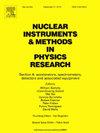A high-precision time-to-digital converter using a multi-cycle sub-interpolation method evaluated in a Kintex-7 FPGA
IF 1.4
3区 物理与天体物理
Q3 INSTRUMENTS & INSTRUMENTATION
Nuclear Instruments & Methods in Physics Research Section A-accelerators Spectrometers Detectors and Associated Equipment
Pub Date : 2025-07-05
DOI:10.1016/j.nima.2025.170828
引用次数: 0
Abstract
In FPGA-based TDC design, the tapped delay line (TDL) method is a classical implementation scheme. However, the inherent delay of TDL can limit the accuracy and resolution of TDC; the inhomogeneity of the delay units and a few ultra-wide delay units can impact the accuracy and induce nonlinearity. In this paper, we propose a multi-cycle sub-interpolation method, which constructs a long TDL and performs multiple repetitive measurements over several cycles after the hit signal arrives. This approach not only effectively enhances the TDC accuracy and reduces differential nonlinearity (DNL), but also eliminates the issue of ultra-wide delay units spanning multiple clock regions in the TDL. We implement a four-cycle sub-interpolation method on an AMD Kintex-7 FPGA, achieving an LSB of 3.11 ps, with a DNL range of (−0.995, 2.757) LSB, an INL range of (−4.315, 14.266) LSB, and a timing precision ranging of (3.6, 4.8) ps at different time intervals.
在Kintex-7 FPGA上对一种采用多周期子插值方法的高精度时间-数字转换器进行了评估
在基于fpga的TDC设计中,抽头延迟线(TDL)方法是一种经典的实现方案。然而,TDL的固有延迟限制了TDC的精度和分辨率;延迟单元的不均匀性和少数超宽延迟单元会影响精度并诱发非线性。在本文中,我们提出了一种多周期子插值方法,该方法构造一个长TDL,并在命中信号到达后的几个周期内进行多次重复测量。该方法不仅有效地提高了TDC精度,降低了差分非线性(DNL),而且消除了TDL中跨越多个时钟区域的超宽延迟单元问题。我们在AMD Kintex-7 FPGA上实现了一种四周期子插值方法,LSB为3.11 ps, DNL范围为(−0.995,2.757)LSB, INL范围为(−4.315,14.266)LSB,不同时间间隔的时序精度范围为(3.6,4.8)ps。
本文章由计算机程序翻译,如有差异,请以英文原文为准。
求助全文
约1分钟内获得全文
求助全文
来源期刊
CiteScore
3.20
自引率
21.40%
发文量
787
审稿时长
1 months
期刊介绍:
Section A of Nuclear Instruments and Methods in Physics Research publishes papers on design, manufacturing and performance of scientific instruments with an emphasis on large scale facilities. This includes the development of particle accelerators, ion sources, beam transport systems and target arrangements as well as the use of secondary phenomena such as synchrotron radiation and free electron lasers. It also includes all types of instrumentation for the detection and spectrometry of radiations from high energy processes and nuclear decays, as well as instrumentation for experiments at nuclear reactors. Specialized electronics for nuclear and other types of spectrometry as well as computerization of measurements and control systems in this area also find their place in the A section.
Theoretical as well as experimental papers are accepted.

 求助内容:
求助内容: 应助结果提醒方式:
应助结果提醒方式:


